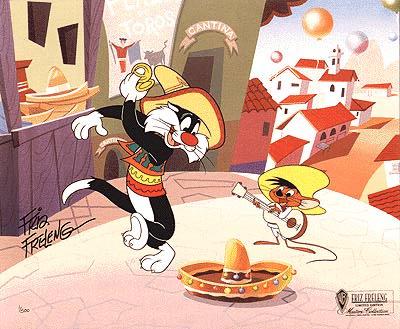Friz Freleng Gallery
Freleng is credited for creating Porky Pig, Yosemite Sam, Sylvester, gangsters Rocky and Mugsy, two Mexicali crows, and cat-chasing canines Spike and Chester, significantly fostering the development of Bugs Bunny and Daffy Duck, refining Tweety from Robert Clampett's riotous and shameless cat-heckler to an innocent-looking but worldly foil for Sylvester, establishing Speedy Gonzales in his ultimate, dapper form, directing the cartoons in which the Goofy Gophers grapple with human industry, and "be-bop"-jazzing a famous fairy tale with "The Three Little Bops" (1957).
After directing approximately 266 Warner Brothers cartoons and surpassing all other animation directors at Warner Brothers in this regard, Freleng joined David H. DePatie in the formation of DePatie-Freleng Enterprises to continue the output of quality, mass-entertaining animation after the closure of Warner Brothers' cartoon studio in 1964. The Pink Panther has been Freleng's principal player for the many decades of DePatie-Freleng's tenure, its signature character- and was selected by Freleng in a 1989 interview as his all-time favorite cartoon personality.
He also delighted in anthropomorphizing the insect world, with mosquitoes and ants becoming tactical combatants against a hapless human in "Of Thee I Sting" (1946) and "Ant Pasted" (1953) respectively, and "The Fighting 69 1/2th" (1941) and "The Gay Anties" (1947) depict ants as self-aware, determined raiders of a picnic. One of the principal characters of Depatie-Freleng's Ant and Aardvark series of cartoons was an extension of this idea.
http://digitalconsciousness.net/top sites/?iy=331

viewer |
|
|
| Pink Panther |
Catdance |
| Yosmite Sam |
| Daffy Duck |
| Showstoppers |
| Magoo |
| Loony Tunes |
Biography
Bulletin Board
Renowned Art
(home)
Freleng simply made good cartoons, and kept making them year after year. He earned his studio three Academy Awards. Freleng's forte was musical cartoons. He animated the Pink Panther series. The diminutive and hotheaded Yosemite Sam was inspired by Freleng.
all artists, with thumbnails: by birth year | alphabetically
all artists: by birth year | alphabetically
artists born in the 13th 14th 15th 16th 17th 18th 19th 20th century